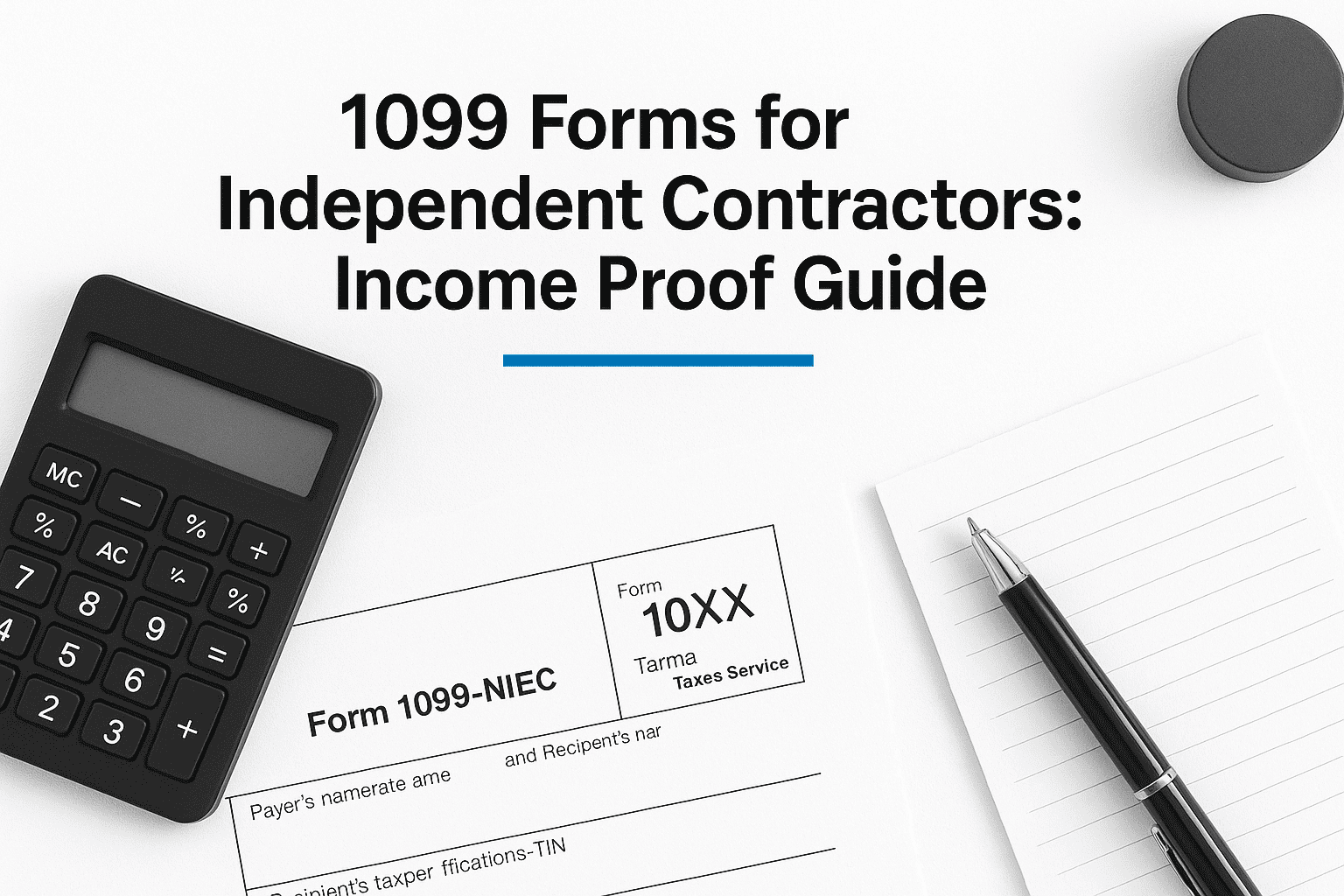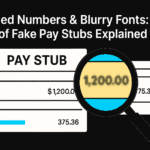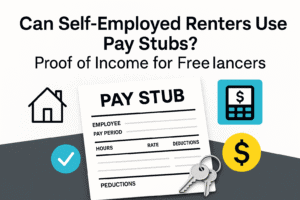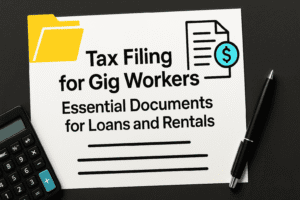Last updated: August 2025
As a self‑employed contractor or freelancer, you don’t receive traditional pay stubs. Instead, you rely on 1099 forms (or their UK and Canadian equivalents) to show lenders, landlords and government agencies what you earned. This guide explains how to use 1099 forms for independent contractors as proof of income, what reviewers look for and which edits are compliant. Our compliance‑first approach keeps documents readable and organized without changing any facts.
Independent contractors often juggle multiple clients, variable payment schedules and different tax rules. Because underwriters and property managers cross‑check your information against bank deposits and tax records, your income packet must be consistent and traceable. We help you assemble, format and present your documents so they’re easy to review. We never fabricate numbers or create tax forms—we organize your authentic records and flag issues that must be corrected at the source.
Related Entities & Terms
- Forms: 1099‑NEC, 1099‑K, 1099‑MISC (US); payslips, P60, P45, SA302 (UK); T4, T4A, Notice of Assessment (NOA), T2125 (Canada)
- Synonyms: self‑employed income, contractor payments, gig‑worker earnings
- Regulators: IRS, CFPB, FTC (US); HMRC, FCA, GOV.UK (UK); CRA, FCAC (Canada)
- Proof documents: invoices, contracts, bank statements, profit & loss (P&L) statements, employer/contractor letters
- Identifiers: Employer Identification Number (EIN), Universal Tax Reference (UTR), Business Number (BN), National Insurance number (NI)
- Verification processes: employment verification, tenant screening, underwriting, immigration proof of funds
- Privacy & tools: redaction, OCR, PDF bookmarks, secure PDF/A conversion
- Concepts: off‑payroll working (IR35), debt‑to‑income ratio (DTI), recordkeeping & audit trail
Throughout this article you’ll see links to official regulators and our own guides. External links open in a new tab (target="_blank") so you don’t lose your place. Internal links take you to related articles on FinancialDocsProvider.com that expand on specific topics.
What are the legal basics of using 1099 forms for income proof?
Using 1099 forms as proof of income starts with correct worker classification and clear, traceable documentation. In the US, independent contractors typically receive 1099‑NEC or 1099‑K forms and must support them with bank statements and invoices. In the UK and Canada, equivalent records—such as SA302/Tax Year Overviews (UK) or NOAs/T4A/T2125 (Canada)—play a similar role.
Authorities weigh behavioural, financial and relational factors when deciding if a worker is an employee or a contractor. In the US, the IRS considers the degree of control over how work is performed, who handles key business aspects and the nature of the relationship. In the UK, HMRC examines control, substitution and mutuality of obligation; IR35 may apply to certain engagements. In Canada, the CRA looks at control, ownership of tools, chance of profit and risk of loss, and the right to hire assistants.
Classification matters because it determines which evidence fits. Employees usually prove income with W‑2s and pay stubs; contractors rely on 1099 forms, invoices and business records. Because contractors do not have withholding, reviewers scrutinize the path from invoice to deposit to annual totals. If you’re unsure about status, seek official guidance and, if necessary, request an IRS determination using Form SS‑8. Misclassification can lead to penalties or application rejections.
Payers also have obligations. In the US, businesses generally must issue Form 1099‑NEC to report non‑employee compensation of $600 or more in a calendar year. The form is filed with the IRS and provided to the contractor. For 1099‑K, platforms and payment processors follow separate thresholds; always check current IRS guidance linked below. Failure to issue required forms can trigger penalties for the payer.
In the UK, self‑employed individuals register for Self Assessment and rely on SA302 Tax Calculations and Tax Year Overviews. Contractors paid via umbrella companies may also have payslips, but underlying invoices and contract summaries substantiate income. In Canada, T4A slips, T2125 statements and Notices of Assessment (NOA) demonstrate income and expenses. Across jurisdictions, presenting genuine, consistent records is essential.
Throughout this guide we use “1099 forms” as shorthand for contractor income statements across jurisdictions. If your packet requires P60/P45 in the UK or T4A/T2125 in Canada, the same principles apply—collect, organize and present authentic records that align with your bank activity and tax filings.

Which edits are allowed on income proof documents?
Formatting and redaction can make your packet easier to review without changing any facts. Reviewers appreciate clean, searchable PDFs with sensible bookmarks and consistent naming. The goal is to organize information so underwriters don’t waste time hunting for deposits, totals or tax lines.
Generally permitted edits fall into four categories: redaction, organization, readability and export fixes. You may redact partial account numbers, personal identifiers or QR codes to protect privacy. You may merge multi‑page statements into a single PDF and add bookmarks—e.g., “Deposits,” “1099‑NEC,” “Invoices”—so reviewers can jump straight to relevant sections. Applying Optical Character Recognition (OCR) to scans makes text searchable and reduces keying errors. Rotating pages, normalizing orientation and improving resolution are also fine, provided you do not alter numbers or wording.
Highlighting is acceptable when it clarifies, not obscures. For example, highlight deposit lines in bank statements that correspond to 1099 payments, then include a concise cover sheet summarizing total 1099 earnings, invoice numbers and payment dates. Keep annotations minimal and never cover original text. Consistency helps: rename files in a standard format (for example, “2024‑1099‑NEC–ClientName–JohnDoe.pdf”) so your packet looks professional.
If your downloads are low‑resolution or mis‑formatted, we can re‑export from the original portal at higher quality. We may also convert images to PDF/A so digital submission portals accept them without error. These improvements enhance legibility and accessibility without touching the underlying data. Our services include proof of income editing and bank statement formatting. Both focus on clarity—we never inflate, reduce or create numbers.
What edits are illegal when preparing 1099 forms?
Altering facts on tax forms, invoices or bank statements is illegal. Fraud statutes, identity‑theft laws and unfair‑practice rules apply in the US, UK and Canada. While formatting is permissible, changing amounts, dates, payees or account details is falsification and can trigger civil or criminal consequences.
Common examples of illegal edits include replacing actual gross earnings with higher figures, shifting deposit dates to mimic stability, changing client names or EINs/UTRs/BNs, deleting transactions to hide gaps or inserting fake deposits. Manufacturing tax forms—such as creating a 1099‑NEC that the payer never filed—is also fraud. Landlords and lenders routinely verify documents with banks, payroll providers and tax agencies; misrepresentation is often detected.
Consequences are serious. Applications may be denied immediately, and some lenders keep internal watchlists for suspected fraud. Regulators or institutions can report suspicious activity, leading to audits, fines or investigations. If a 1099 form or bank statement contains an error, the lawful remedy is a correction from the source. Do not attempt to “fix” the PDF yourself. Our article on disputing bank statement errors explains how to address mistakes properly.
When do you need professional document formatting?
Some applicants can assemble their income packet on their own, but many benefit from professional support—especially when deadlines are tight or records come from multiple sources. Below are scenarios where expert formatting saves time and reduces rejection risk.
Renters and lease applicants
Landlords want consistent income that comfortably covers rent and living costs. Employees can often rely on two to four recent pay stubs and a W‑2. Independent contractors should provide at least 12 months of bank statements highlighting client deposits, 1099 forms for the latest tax year, invoices for major clients and a simple profit‑and‑loss summary. In the UK, use SA302 Tax Calculations and Tax Year Overviews; in Canada, provide your latest Notice of Assessment and T2125 statement. A professional can combine everything into one bookmarked PDF and redact sensitive details to streamline review. For rental‑specific guidance, see how six months of bank statements win rental applications.
Mini‑scenario: Alex, a freelance designer, has four recurring clients plus occasional marketplace work. We line up Alex’s 1099‑NEC and 1099‑K totals with 12 months of bank deposits, add an invoice index and produce a one‑page summary showing average monthly income and seasonality. The landlord sees a clear trail from invoice to deposit to annual totals.
Auto loans and car financing
Auto lenders evaluate debt‑to‑income ratios and want to see steady earnings. Contractors should include 1099‑NEC/1099‑K forms, 12 months of statements, invoices and a Schedule C summary from the most recent return. UK applicants may submit payslips or Self Assessment documents; Canadians often provide T4/T4A slips and NOAs. Because lenders scrutinize deposit patterns, legible statements and clear highlights matter. Our car‑loan pay stub guide explains these requirements in detail.
Dealer‑day checklist: Bring your driver’s license, proof of address, 1099 forms, bank statements, recent tax return and proof of insurance. If your income varies, include upcoming contracts to show continuity of work.
SBA and small‑business loans
Government‑backed loans require comprehensive documentation. Contractors should supply 1099 forms for the most recent year, 12–24 months of bank statements, detailed invoices and, ideally, accountant‑prepared P&L and balance‑sheet reports. A professional service aligns these documents; mismatched totals between invoices, bank deposits and 1099 amounts are common rejection triggers.
Microloan vs. term loan: Microloans often focus on cash‑flow sufficiency and recent activity, so a crisp bank‑statement packet is critical. For larger loans, add aged receivables, business tax returns and entity documents. We structure files so reviewers can reconcile totals in minutes.
Immigration and visa applications
Visa officers verify that you have sufficient funds and stable income. Self‑employed applicants should provide 1099 forms, bank statements showing deposits, tax returns and, when available, contracts or client letters. For UK visas, include SA302s and Tax Year Overviews; for Canadian applications, include NOAs and T2125 statements. Documents must be in English (or accompanied by certified translations), and scans should be clear and complete.
Tip: Include a brief cover letter explaining your business model, primary clients and typical billing cycle. This context helps officers interpret seasonality and multi‑platform income.
General self‑employment evidence
Even outside loans and leases, you may need income proof for purposes like insurance, child support or retirement planning. Keep 1099 forms, invoices, contracts and bank records organized year‑round. A professional can digitize paper receipts, apply OCR for searchability and maintain a secure document archive with consistent naming and indexing.
Audit‑ready habits: Save PDFs straight from source portals, avoid screenshots, and keep a monthly reconciliation worksheet tying invoices to deposits. Those simple steps minimize questions later.
How does our process work?
Our role is to edit, format and organize your existing financial documents. We never add, remove or alter factual information. Here’s how our process keeps your packet compliant and easy for reviewers to assess:
- Intake & consultation: Tell us what you’re applying for—rental, auto loan, SBA loan, immigration or something else. We discuss required documents based on your status (employee vs. contractor) and jurisdiction (US, UK, Canada). When you’re unsure, we point you to official resources or our 1099 contractors vs employees guide.
- Document collection: You upload your raw PDFs (bank statements, 1099 forms, invoices, tax returns, NOAs). We never request your online‑banking login or ask you to fabricate anything. Data is encrypted in our secure portal.
- Reconciliation & organization: We cross‑reference deposits, totals and dates across documents to ensure consistency. For example, we match 1099 amounts to bank credits and note discrepancies for you to resolve. We assemble your packet in logical order: cover summary, tax forms (1099s, SA302, NOA), invoices, bank statements and any supporting letters.
- Formatting & redaction: We apply OCR where needed, rotate pages, normalize resolution and add bookmarks. We redact partial account numbers and other sensitive data while preserving transaction details. If a page is illegible, we request a cleaner copy rather than “enhancing” numbers.
- Delivery & follow‑up: You receive a secure, reviewer‑ready PDF packet. Review it carefully before submission. If reviewers ask for tweaks (for example, removing a page or adding an invoice), we handle the adjustments. When a factual discrepancy arises, we explain how to obtain corrected documents from the source—we do not alter facts.
Security & boundaries: We provide document editing and organization. We are not a law firm or tax advisor, and we do not issue or file tax forms. We retain files only as needed to complete your order, then purge per policy. For pricing, see our pricing page. To learn about our philosophy and credentials, visit our about page.
What should be on your compliance checklist?
Assembling a complete, compliant packet takes more than gathering 1099s. Use this checklist to avoid gaps and make review fast. Adapt it to your jurisdiction and use case.
- Collect the right tax forms: US – 1099‑NEC/1099‑K/1099‑MISC and prior‑year return or Schedule C; UK – SA302 and Tax Year Overview; Canada – NOA, T4A and T2125.
- Gather bank statements: At least 12 months for contractors. Highlight deposits that match 1099 amounts and invoices. Ensure names and account numbers match your ID.
- Include invoices and contracts: Provide signed contracts or statements of work for major clients. Ensure invoices show dates, amounts and services performed.
- Prepare a profit‑and‑loss summary: Create a simple P&L listing monthly revenue and expenses. Generate it from accounting software or a spreadsheet to help reviewers assess stability.
- Organize supporting letters: Include letters from clients, accountants or umbrella companies confirming your role and payment terms. For employees, include employer letters or a formal income verification letter.
- Ensure consistency: Totals on tax forms should tie to invoices and the sum of bank deposits. If timing differences exist, include a short explanation on the cover page.
- Redact sensitive information: Mask partial account numbers, SSN/NI numbers and QR codes, but leave enough detail for reviewers to trace deposits.
- Use clear file names: Name files consistently (for example, “2024‑1099‑NEC–ClientA.pdf,” “2024‑03 Bank Statement.pdf”).
- Double‑check dates: Confirm documents cover the requested period. If a statement is missing, request it from your bank before submission.
- Review legibility: Ensure scans are high‑resolution and text is readable. Apply OCR so PDFs are searchable.
- Package into a single PDF (when allowed): Combine documents with bookmarks for easy navigation. Otherwise, place them in a zipped folder with a clear index.
- Translations & certifications: If documents aren’t in English, include certified translations. For bank letters or accountant attestations, use signed PDFs on letterhead.
- Proof of identity & address: Keep a current photo ID and recent utility bill or bank letter ready; many reviewers ask for them alongside income proof.
Completing this checklist reduces back‑and‑forth and speeds up approvals. If you’re unsure about any item, reach out via our contact form.
What red flags should you avoid?
Underwriters, landlords and immigration officers are trained to spot inconsistencies. Avoid the pitfalls below to prevent delays or rejections.
- Mismatched totals: The sum of invoices and deposits should align with totals on your 1099 forms. If timing differs, include a brief explanation.
- Inconsistent names or entities: Keep your name and business name consistent across tax forms, bank statements, invoices and ID. Nicknames or abbreviations can create confusion.
- Unusual deposit patterns: Sudden large deposits, erratic timing or unexplained transfers raise questions. Provide context if you have seasonal spikes or multi‑platform income.
- Low balances or overdrafts: Frequent overdrafts, negative balances or returned items can signal instability. Maintain healthy balances when submitting statements.
- Illegible documents: Poor scans, missing pages or low‑quality exports frustrate reviewers. Replace with clean copies.
- Fake or altered documents: Using fabricated pay stubs or edited tax forms is illegal and commonly detected through verification databases. When in doubt, disclose and correct via proper channels.
- Unexplained income gaps: If you took time off or changed industries, add a sentence of context or a supporting letter.
- Missing signatures: Contracts or letters without signatures or letterhead may be discounted. Provide signed versions.
- Out‑of‑date paperwork: Many reviewers require recent statements (often the last 12 months). Submitting outdated documents suggests your records aren’t current.
- Metadata mismatches: PDF dates or page counts that don’t match bank statements can raise flags. Export documents directly from source portals when possible.
- Round‑number anomalies: Lots of round‑number invoices or deposits may look suspicious. Show detailed invoices that match real work performed.
Proactively addressing these items improves credibility. Transparency and organization go a long way.
Where can you find official resources & further reading?
Regulatory guidance changes over time. Use these official sources and in‑depth guides to stay current and build solid, verifiable packets.
- IRS: Independent contractor or employee? – overview of the factors used to classify workers in the United States.
- IRS: Reporting payments to independent contractors – when payers must file Form 1099‑NEC and general thresholds.
- GOV.UK: Employment status – guidance on worker status and rights under UK law.
- CRA: Employee or self‑employed – factors used to determine self‑employment in Canada.
- 1099 contractors vs employees: income verification guide – our comparison of documentation requirements with mini‑scenarios.
- How to write an income verification letter – step‑by‑step instructions to complement your 1099 forms.
- Rental application documents guide – how to package documents for landlords and property managers.
- How to fix a bank statement error legally – how to resolve statement inaccuracies through official channels.
- How landlords and loan officers detect fake pay stubs – tools, databases and practices used to spot falsification.
Bookmark these resources for future reference. They’ll help you stay compliant and informed as rules evolve.
FAQs
Q1: Do I need to file a 1099 form as an independent contractor?
A: No. You are the recipient of the 1099 form; your clients or platforms issue it to the IRS and send you a copy if they paid you at least $600 in a year. Keep copies for your records and include the income on your return. If you didn’t receive a form, you must still report the income.
Q2: What’s the difference between 1099‑NEC, 1099‑K and 1099‑MISC?
A: Form 1099‑NEC reports non‑employee compensation for services. 1099‑K reports payments processed through third‑party networks (for example, cards or apps) once the relevant threshold is met. 1099‑MISC covers miscellaneous income such as royalties or rent. You may receive multiple forms depending on how you’re paid.
Q3: Can I edit my 1099 form to correct an error?
A: No. Contact the payer and request a corrected form. Editing tax forms yourself is illegal and considered falsification. Similarly, if a bank statement shows an incorrect deposit, work with your bank to correct the record instead of altering the document.
Q4: How far back should my bank statements go?
A: Independent contractors should include 12 months of statements to show income consistency. Some lenders or landlords may request 24 months. Always match the timeframe specified in the application and highlight deposits linked to your 1099 earnings.
Q5: What if my income is seasonal or varies month to month?
A: If your earnings fluctuate, include a brief explanation in a cover letter or income summary. Provide invoices or contracts showing future work and maintain larger cash reserves. A professional service can organize documents to emphasize stability and contextualize seasonal spikes.
Need accurate, reliable financial documents fast? Contact FinancialDocsProvider.com now.
About the author: The FinancialDocsProvider.com Editorial Team — Our team comprises compliance professionals, former underwriters and financial editors with decades of experience helping clients across the US, UK and Canada organize proof‑of‑income packets. We stay up to date with regulatory guidance and lend our expertise to renters, borrowers and small‑business owners. Learn more about us on our about page.
FAQ Copy Block for Rank Math:
Q: Do I need to file a 1099 form as an independent contractor? A: No. Your clients or platforms issue 1099 forms to the IRS if they pay you at least $600 in a year; you should keep copies and report the income, but you do not file the form yourself.
Q: What’s the difference between 1099‑NEC, 1099‑K and 1099‑MISC? A: 1099‑NEC reports non‑employee compensation for services, 1099‑K reports payments processed via third‑party networks, and 1099‑MISC covers miscellaneous income like royalties and rent.
Q: Can I edit my 1099 form to correct an error? A: No. Request a corrected form from the payer; editing tax documents yourself is illegal and considered falsification.
Q: How far back should my bank statements go? A: Contractors should include at least 12 months of statements to show consistency; some applications require 24 months.
Q: What if my income is seasonal or varies month to month? A: Provide context in a cover letter, include future contracts and maintain cash reserves; organize documents to highlight stability.








Add comment